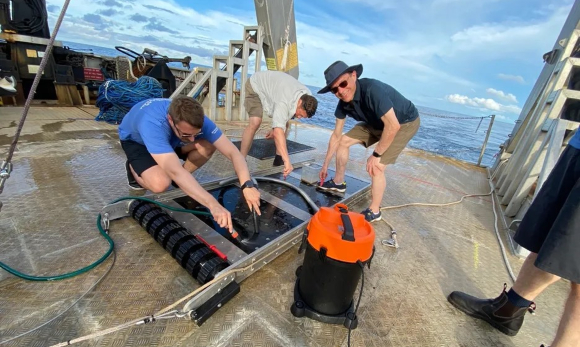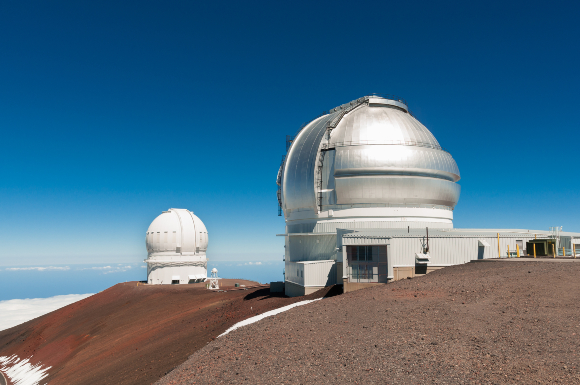Findings by an American-Israeli researcher support the hypothesis that a meteorite that hit the Pacific Ocean originated outside our solar system. Lunar soil temperature extremes revealed, new concerns related to space debris and a troubling cyber-attack targeting scientific telescopes. This Week in Space
Fragments from Another Star
A team led by the American-Israeli researcher Abraham (Avi) Loeb from Harvard University, has reported discovering remnants of a meteorite that exploded in the skies over the Pacific in 2014. According to them, this finding lends strong support to the hypothesis that the meteorite originated from deep space. "We've never seen anything like this in our solar system," Loeb said in an interview with the Davidson Institute.
The meteorite, designated CNEOS 2014-01-08, exploded in the atmosphere approximately 180 kilometers off the coast of New Guinea. In 2019, Loeb and his research student, Amir Siraj, hypothesized that based on its speed its origin was likely to be in another solar system. However, they lacked solid evidence. Last year, the US Space Force confirmed the meteorite's velocity, indicating that it moved at an astonishing speed of about 45 kilometers per second. This validation enabled Loeb and Siraj to publish their calculations in a scientific paper.
Next, an expedition set out to search for the meteorite's remnants. Loeb, who leads the Galileo project, which aims to detect extraterrestrial life using advanced instruments, raised the funds for a research voyage that set out in June this year. This voyage employed a magnet, roughly the size of a single bed, which scoured the seabed approximately two kilometers deep, after Loeb and his colleagues narrowed down the search area based on precise calculations of the meteorite's impact location. They separated volcanic ash particles that adhered to the magnet and searched among them for tiny metal spheres. "As the meteorite blazed through the atmosphere, it heated up and the more volatile metals composing it evaporated," Loeb explained. "The less volatile metals melted, and upon contact with air or water, cooled into minuscule spheres. These spheres - which can be less than a millimeter in size - are what we were looking for."

IMspherules - Minuscule spherules measuring only a few thousandths of a millimeter across. An electron microscope image of two such spherules discovered by the research team | Source: Avi Loeb, Harvard University
Eventually, the research team identified close to 700 such spherules, with sizes ranging from 0.05 millimeters to 1.3 millimeters. A significant portion of these was clustered in three distinct areas on the ocean floor, while no traces were found in magnet surveys conducted elsewhere. Utilizing an electron microscope, the researchers closely studied the spherules. They also employed a mass spectrometer, a device that can identify the elements that compose these spherules, to determine the chemical makeup of selected samples.
Examinations uncovered unexpectedly high concentrations of certain metals within some spherules — concentrations that surpass those seen in meteorites from our solar system. Notably, there were elevated levels of the metals Beryllium (Be), Lanthanum (La), and Uranium (U), earning them the nickname "BeLaU spherules". "The concentrations are notably different from those on Earth and far exceed the known composition of the early solar system," highlighted Loeb
The team also analyzed the spherules' iron isotope composition. Iron, akin to other elements, exists in varied forms that have similar chemical traits but differ in mass due to differences in the number of neutrons in their nuclei. The quantitative ratios between iron isotopes 54, 56, and 57 — in the spherules varied significantly compared to compositions originating from Earth or meteorites from other planetary bodies within the solar system. "This difference reinforces the assumption that this meteorite came from another solar system," stated Loeb. Therefore, the researchers named it IM1, an abbreviation for Interstellar Meteorite 1.
The researchers do not currently have an answer to the most intriguing question: where did this meteorite come from? In the research paper, which is yet to undergo peer review prior to publication in a scientific journal, Loeb and his colleagues suggest that one possibility is that it was formed in the crust of an iron-core planet in a distant solar system. However, this doesn't explain its immense speed, among other issues. Another explanation might be that it was formed in an energy-intensive cosmic event, such as a core-collapse supernova (a dramatic explosion of a giant star), or a neutron star merger (a type of stellar collision). This might explain the high concentration of heavy elements, but not necessarily the other element concentrations in the spherules.
“A more exotic possibility,” the researchers write, “is that this unfamiliar abundance pattern, with uranium being nearly a thousand times more abundant than the standard solar system value, may reflect an extraterrestrial technological origin” They further note that these interpretations will will be considered critically in future research along with additional results from spherule analysis
"If we had a way to deduce the meteorite’s age, for example, from the half-life of radioactive elements, we could estimate, based on its speed, the distance it traveled, and get an idea of where it came from," Loeb explained. "Unfortunately, we lack this capability. Perhaps we'll uncover more answers during an expedition planned for next year, aimed at locating larger fragments of the meteorite." When asked about any scientific basis to question the meteorite's natural origin, he candidly replied, "No. Judging by its composition, we cannot definitively assert its non-natural origin. However, as we haven't encountered such specimens in our solar system, I remain open-minded. If we find a larger remnant, maybe we can determine that. What's remarkable here is that while in the past we sought objects beyond our solar system using telescopes, today we're doing it with microscopes."
However, not all researchers concur with Loeb’s findings, and fewer still with his interpretation. Some scientists interviewed for New Scientist pointed out that even if the collected particles originated from the meteorite, they might have undergone transformations during their time on the ocean floor, which may have altered their composition. According to these researchers, the unique composition doesn't necessarily indicate that the meteorite came from outside our solar system, and much more substantial evidence is necessary to validate such a claim.

"While it’s not yet possible to determine that it has an extraterrestrial technological origin, our research continues." Loeb (with the hat) and his colleagues during the collection of samples from the ship's magnet. | Photo courtesy of Avi Loeb, Harvard University.
The Insulating Lunar Sand
Following the successful landing of the Indian spacecraft Chandrayaan-3 near the moon's south pole last week, the scientific mission of the Vikram lander and the Pragyan rover is underway. This mission is expected to span one lunar day, which is equivalent to approximately two weeks on Earth. This week, the Indian Space Agency reported that Vikram conducted the first direct measurements of ground temperature in the area, utilizing an instrument capable of penetrating the lunar soil to a depth of about ten centimeters. The findings were surprising: despite a notably warm surface temperature of approximately 60 degrees Celsius, at a mere depth of eight centimeters, the temperature plunged to a frigid 10 degrees Celsius below zero.
The discovery regarding the substantial thermal insulation properties provided by the regolith – the lunar soil – sparks optimism for the potential discovery of frozen water in proximity to the moon's surface. Even if not achieved during this specific mission, subsequent robotic expeditions targeting the same region hold promise. These endeavors are stepping stones towards the first human landing in this area of the moon, as part of the Artemis program, currently set for 2026. The potential existence of substantial ice deposits offers prospects beyond water for sustenance and agriculture, such as oxygen for respiration, as well as oxygen and hydrogen as critical components for propelling rockets, other aircraft, or rovers.
First measurements yield interesting results. The Vikram landing, as captured by the Pragyan rover. The probe's arm is visible close to the left landing leg | Source: ISRO.
Old Junk, New Debris
A satellite, over three decades old, launched into space at the end of the days of the Soviet Union, disintegrated in Earth’s orbit, due to a likely collision with space debris, in an event that generated an entire cloud of new debris particles. The event was reported this week by American astronomer Jonathan McDowell, who among other things specializes in space debris. He speculates that the disintegrated satellite could be either Kosmos-2143 or Kosmos-2145, both part of a set of eight communication satellites jointly launched by the Soviet Union in 1991. These satellites, which have long been inoperative, remained in an orbit at an altitude of 800 kilometers - a particularly problematic height due to the thin atmosphere and lack of sufficient particle density to create drag capable of slowing down the satellites, eventually leading to their collision.
This is not the first occurrence involving old Soviet satellites in such space accidents. The concern lies in the fact that each collision generates more debris particles, which can subsequently impact other satellites, generating even more debris in an ongoing cycle. Breaking this cycle would likely require a comprehensive international effort to address the cleaning of space debris.

Each collision creates more and more debris particles. Fragments of space debris in orbit around Earth | Illustration: Frame Stock Footage, Shutterstock
Cyber and Space
In recent weeks, a cyber-attack disabled some of the world's most critical research telescopes. The attack targeted the communication system of the NOIRLab astronomical research facility, operated by the United States' National Science Foundation (NSF). This communication system allows researchers from across the globe to operate NOIRLab's telescopes remotely, including the prominent Gemini North in Hawaii, Gemini South in Chile, and eight smaller telescopes in Chile. Following the attack, detected on August 1st, the organization suspended the telescopes' operations, and scientists had to cancel observations planned many months in advance. "Our staff are working with cybersecurity experts to get all the impacted telescopes and our website back online as soon as possible, ” read a statement on the NOIRLab website.
Cybersecurity experts remain uncertain about the motive behind the attack on the telescopes' data networks. No ransom demands have been reported thus far. “Quite possibly, the attacker doesn’t even know they are attacking an observatory,” said cybersecurity expert Von Welch to Science magazine. Just two weeks ago, the U.S. National Counterintelligence and Security Center (NCSC) – part of the intelligence community – issued a warning concerning cyber attacks targeting the American space industry, with substantial security implications. Private companies such as SpaceX often launch satellites for entities such as the Defense Department, Space Force, and various other military and intelligence agencies.
Although the research telescopes are not associated with security operations, this incident isn't the first time a scientific astronomical institution falls victim to such an attack. Less than a year ago, the ALMA radio telescope in Chile was shut down for several weeks due to a cyber attack. Evidently, there is a pressing need to enhance information security measures, even within establishments dedicated to basic scientific research.

Striving to restore disabled telescopes back into operation. The Gemini North telescope in Hawaii | Photo: MarkoBeg, Shutterstock.

